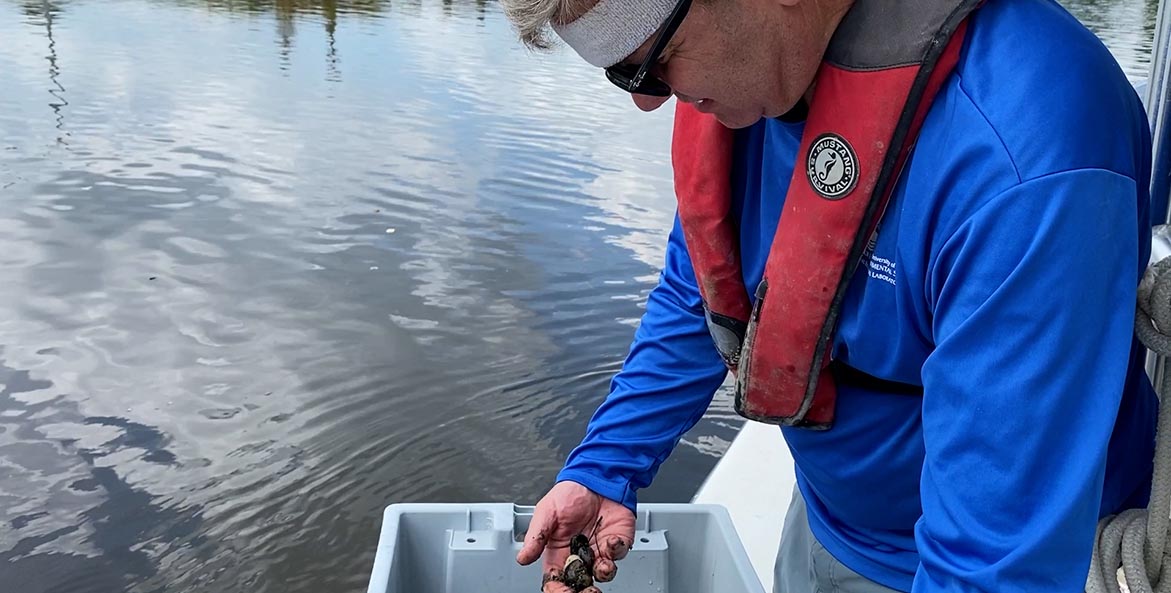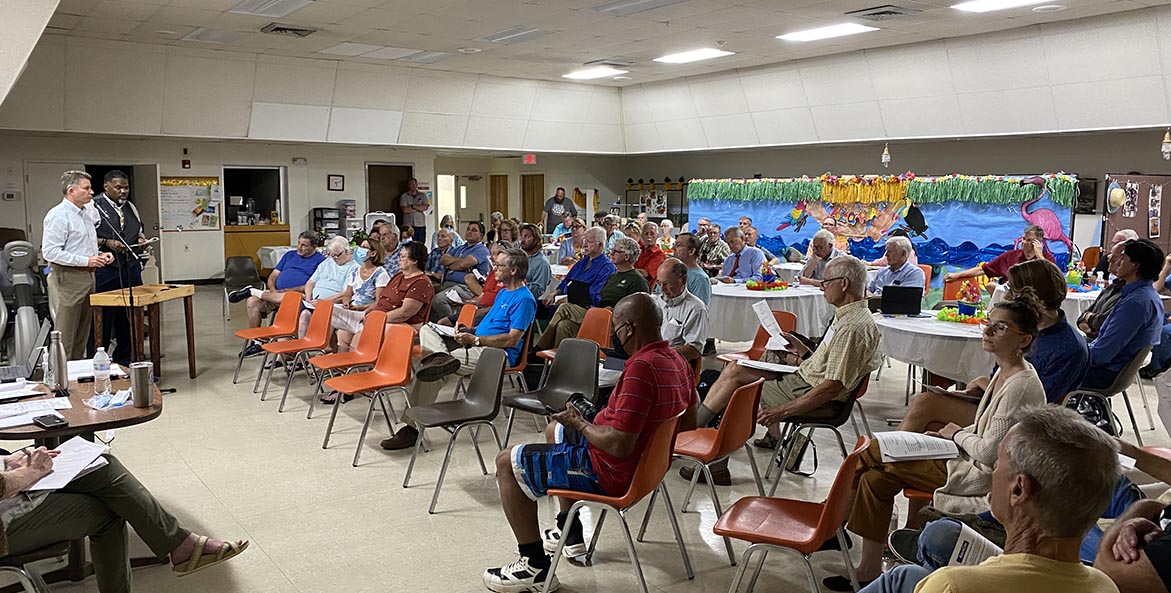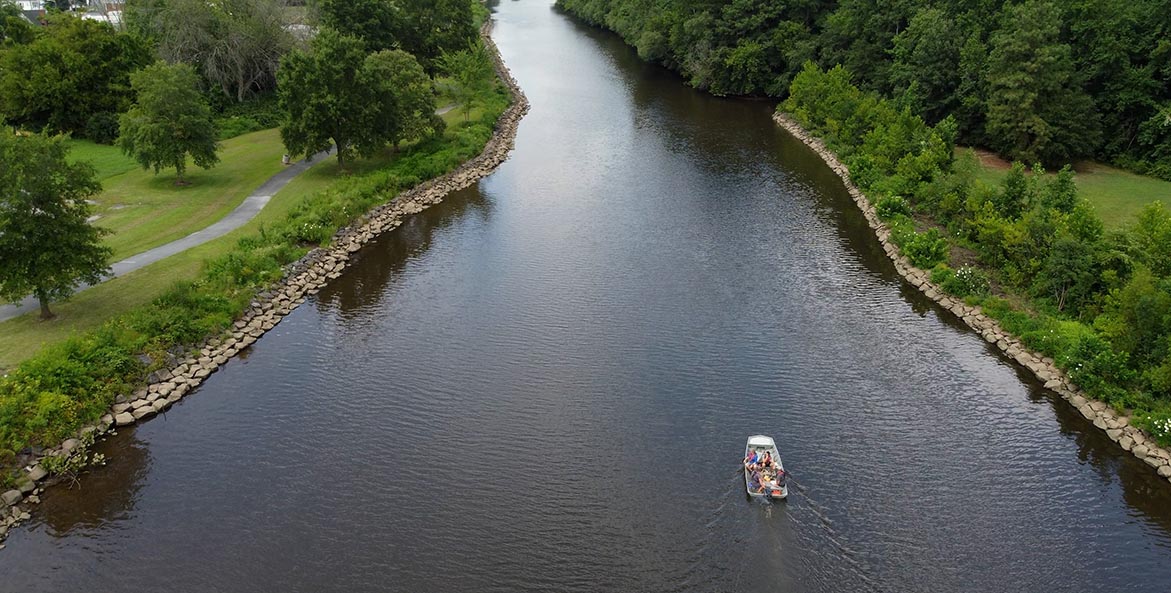Dr. Dave Secor wasn't mincing words.
The University of Maryland Center for Environmental Science professor came to the August public hearing in Federalsburg to explain the risks to Maryland's endangered Atlantic sturgeon posed by a super-sized salmon factory being pitched by the start-up Norwegian company AquaCon.
In front of a crowd of more than 75 town residents, environmental advocates, and worried scientists , Dr. Secor pulled from his pocket a handful of small stones. He grabbed the cobble earlier that day from the bottom of Marshyhope Creek where AquaCon wants to discharge 2.3 million gallons per day of salmon-waste-tainted purge water from their proposed factory —potentially polluting the stream with nutrient pollutants that exceed Chesapeake Bay limits. The discharge site at the creek spans about 75 feet and is wadable at low tide.

Dr. Dave Secor examines cobble pulled from the bottom of Marshyhope Creek near the proposed AquaCon discharge site on August 10, 2022.
A.J. Metcalf/CBF Staff
"You can see cobble in the banks of the creek," Secor said. "This is unique habitat for sturgeon in Maryland waters. "Atlantic sturgeon come here year after year after year. AquaCon is an existential threat to the smallest of Atlantic sturgeon populations, and that's a very bold statement. And I say that because our best estimate for the spawning run last year from recapture and side scan sonar is 29 fish. That would make it the smallest Atlantic sturgeon population in the world, in the smallest river system where we know Atlantic sturgeon are capable of spawning."
Secor noted that the ancient fish, like other anadromous species, return to the waters where they were born to spawn and depend on the tiny stones in the river to lay their eggs. He urged AquaCon to find a different waterway to discharge into.
The Public Hearing
Secor, whose team of scientists has tracked sturgeon in the Marshyhope for more than a decade, was among two dozen speakers at the hearing who oppose AquaCon's plan to build a 25-acre indoor salmon factory on farmland annexed for the project in Federalsburg. Except for AquaCon's affiliates, no one spoke in support of the plan at the August 10 hearing held by the Maryland Department of the Environment (MDE).
The hearing was among the first official gatherings where the public had the opportunity to provide input on AquaCon's plans to raise about 15,000 tons of salmon per year. Among concerns about stormwater runoff, nutrient pollution, catastrophic failures at other land-based salmon plants, and the well-being of the Marshyhope, sturgeon took center stage.
"I question why an above-ground salmon farming facility is proposed to be built on the shores where this delicate population of fish spawns," said Sharpsburg resident Mollie Rudow.
"We don't want this to be the last nail in the coffin of the Bay, and the last nail in the Atlantic sturgeon," said Susan Andrew who lives on the Faulkner Branch of the Marshyhope.
"This permit is missing significant technical information," said CBF's Eastern Shore Director Alan Girard. "It ignores the concerns expressed by the state's own scientists that impacts to the endangered Atlantic sturgeon will occur." Girard was referring to several questions raised by the state's Department of Natural Resources that is supposed to work closely with MDE when writing permits, though it's not clear that's happening.

Attendees at the MDE public hearing for AquaCon's proposed discharge permit on August 10 in Federalsburg, MD.
A.J. Metcalf/CBF Staff
The Ancient Fish
Atlantic sturgeon, the largest fish native to the Chesapeake Bay, are a strong indicator of healthy water quality. The fish are "very sensitive to low oxygen, pollution, and other poor water conditions" according to EPA's Chesapeake Bay Program. The Bay's sturgeon population has cratered since colonial times. Captain John Smith, when he first explored the Bay in 1608, described seeing more sturgeon in the water "than could be devoured by dog or man."
Overfishing for caviar production, pollution, and shoreline development have wiped out most of the Bay's native sturgeon populations and their riverbed cobble habitat. Scientists still track small populations in a few rivers in Virginia and the Marshyhope Creek and its connected Nanticoke River in Maryland.
The Opposition
CBF is working with residents, scientists, and community leaders to oppose the discharge permit for AquaCon and to protect water quality in the Marshyhope, which contains the only federally designated sturgeon habitat in the state.
Secor said his team has tracked sturgeon swimming upstream past the proposed discharge point for the AquaCon factory. He said small changes in water quality—such as salinity changing one half part per thousand—would kill sturgeon embryos. Water temperature requirements, which are vastly different for salmon and sturgeon, also raise questions about how—or whether—MDE can effectively regulate the temperature of the discharge. Secor urged MDE and AquaCon to find a different location that would not threaten the last few remaining sturgeon in Maryland.
"There are other siting choices for AquaCon, those, particularly, that mitigate the risk by discharging into larger bodies of water," Secor said.
MDE is accepting public comments through October 17 on the proposed discharge permit.




